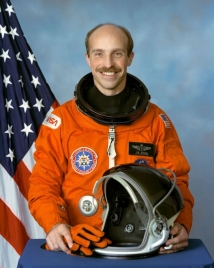James Bagian
Monday, February 17, 2025
Born February 22, 1952, in Philadelphia, Pennsylvania. Married to the former Tandi M. Benson of Seattle, Washington. They have four children. He enjoys bicycling, backpacking, climbing, swimming, flying, and racquet sports, as well as cabinet-making and automobile rebuilding. His parents, Philip and Rose Bagian, reside in Philadelphia, Pennsylvania. Her parents, Boyd and Barbara Benson, reside in Seattle, Washington.
Graduated from Central High School in Philadelphia, Pennsylvania, in 1969; received a bachelor of science degree in mechanical engineering from Drexel University in 1973, and a doctorate in medicine from Thomas Jefferson University in 1977.
Bagian became a NASA astronaut in July 1980. He took part in both the planning and provision of emergency medical and rescue support for the first six Shuttle flights. He also served as the Astronaut Office coordinator for Space Shuttle payload software and crew equipment, as well as supporting the development of a variety of payloads and participating in the verification of Space Shuttle flight software. In 1986, Dr. Bagian served as an investigator for the 51-L accident board. He has also been responsible for the development program and implementation of the pressure suit used for crew escape and various other crew survival equipment to be used on future Shuttle missions, and is in charge of Shuttle search and rescue planning and implementation for the Astronaut Office. Dr. Bagian has also been a member of the NASA Headquarters Research Animal Holding Facility Review Board. He has authored numerous scientific papers in the fields of human factors, environmental and aerospace medicine. A veteran of two space flights (STS-29 in 1989 and STS-40 in 1991), Dr. Bagian has logged over 337 hours in space.
Dr. Bagian first flew on the crew of STS-29, which launched from Kennedy Space Center, Florida, aboard the Orbiter Discovery, on March 13, 1989. During this highly successful five-day mission, the crew deployed a Tracking and Data Relay Satellite and performed numerous secondary experiments, including a Space Station -heat pipe" radiator experiment, two student experiments, a protein crystal growth experiment, and a chromosome and plant cell division experiment. Also, Dr. Bagian was the principal investigator and performed Detailed Supplementary Objective 470 which described, by the use of transcranial Doppler, the changes of cerebral blood flow and its relationship to Space Adaptation Syndrome (SAS) and Space Motion Sickness (SMS). Dr. Bagian was the first person to treat SMS with the drug Phenergan by intramuscular injection. This represented the first successful treatment regimen for SMS and has now been adopted by NASA as the standard of care for the control of SMS in Shuttle crews and is routinely used. In addition, the crew took over 3,000 photographs of the Earth using several types of cameras, including the IMAX 70 mm movie camera. Mission duration was 80 orbits and concluded with a landing at Edwards Air Force Base, California, on March 18, 1989. With the completion of this mission, he logged over 119 hours in space.
More recently, Dr. Bagian served on the crew of STS-40 Spacelab Life Sciences (SLS-1), the first dedicated space and life sciences mission, which launched from the Kennedy Space Center, Florida, on June 5, 1991. SLS-1 was a nine-day mission during which crew members performed experiments which explored how the heart, blood vessels, lungs, kidneys, and hormone-secreting glands respond to microgravity, the causes of space sickness, and changes in muscles, bones, and cells which occur in humans during space flight. Other payloads included experiments designed to investigate materials science, plant biology and cosmic radiation. In addition to the scheduled payload activities on STS-40, Dr. Bagian was successful in personally devising and implementing repair procedures for malfunctioning experiment hardware which allowed all scheduled scientific objectives to be successfully accomplished. Following 146 orbits of the Earth, Columbia and her crew landed at Edwards Air Force Base, California, on June 14, 1991. Completion of this flight logged him an additional 218 hours in space.
Dr. Bagian is taking a leave of absence from NASA. He is currently involved in both the practice of occupational medicine and biomedical research.





